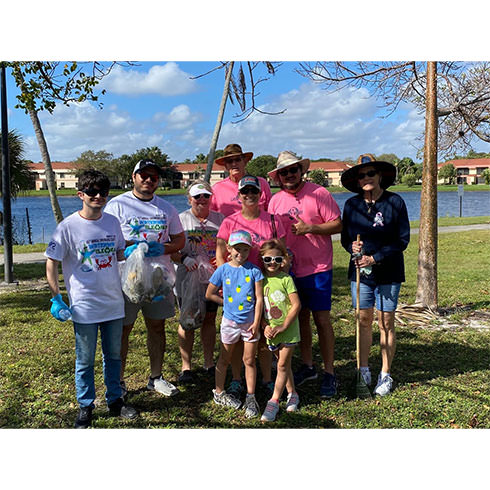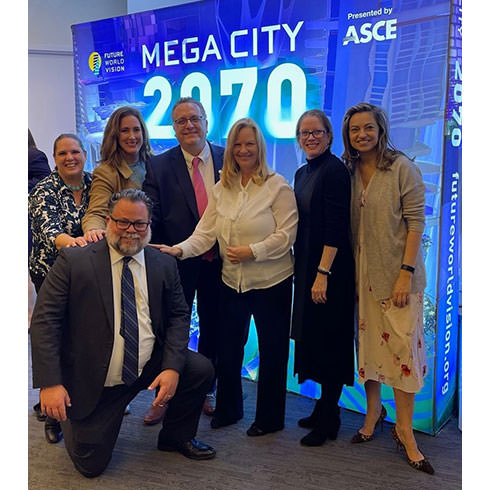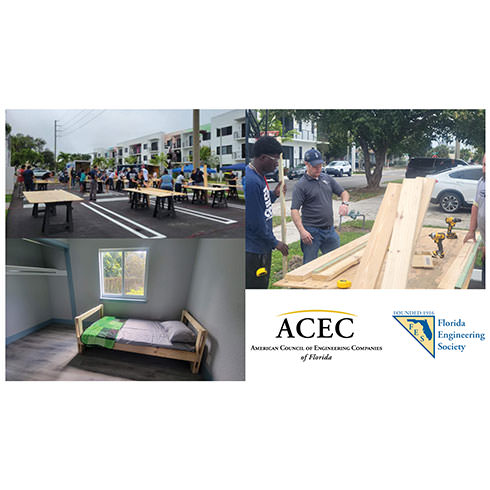


Peter M. Moore, P.E., F.ASCE, FACEC Running for 2023 ASCE President
Running for President-Elect for American Society of Civil Engineers (ASCE), Peter Moore is combining his 25 years of service to the engineering profession, his dedication to ASCE, and coupled with his strong leadership background in business and the non-profit world, to support his candidacy. Peter’s Vision Statement for ASCE is available online and focuses on Accountability (fiscally), Advocacy (efficacy) and Accessibility (diversity). He believes strongly in the idea that student membership satisfaction and conversion is the key to the long-term success of the organization. Having led a successful civil engineering firm for 20 years, Peter is determined to provide a lasting legacy to ASCE and the Civil Engineering Industry as a whole.
Currently, Peter serves as the President and CEO of Chen Moore and Associates, an approximately 100-person multidisciplinary firm in the Southeast US, particularly Florida. Having been with the firm for over 22 years, Peter helped grow the firm from three people to its current size with a combination of strong vision and the highest quality consulting.Please visit https://www.asce.org/about-asce/elections to vote!
SunSentinel Mention
Peter Moore, P.E., F.ASCE, FACEC
President, Chen Moore and Associates
As published by the Sun Sentinel on April 2, 2022
We are barely scratching the surface. What’s next for our nation’s infrastructure? | Opinion
On Nov. 15, 2021, President Joe Biden signed the Infrastructure Investment and Jobs Act of 2021 (IIJA) into law. The White House has considered this to be “a once-in-a-generation investment in our nation’s infrastructure and competitiveness.” As a civil engineer, I give credit to all the politicians involved in creating excitement around infrastructure funding. We can point to this act as only progress, and we can now begin to measure the impact of this investment and, more importantly, we can begin to measure the multiplicative return on investment that is well-documented from past investments. And from what we can measure, a trillion dollars doesn’t go too far.
Despite all the appreciation that I have as a civil engineer and a citizen, the IIJA barely the scratches the surface of our nation’s needs, and if this is the only investment in infrastructure in this generation, the United States will fall even further behind on the world stage. This is evident on a couple of levels.
When the average person hears about a $1.2 trillion investment, it sounds more than sufficient to meet our needs, but in reality, it falls far short. The first example of this shortfall is the fact that, of the $1.2 trillion, only $550 billion is actually new money programmed to be spent on transportation, water and power infrastructure and pollution cleanup. The remainder, more than half, is simply regular annual spending on infrastructure projects.
Drawing on the technical knowhow of its membership, the American Society of Civil Engineers (ASCE) produces independent reporting on America’s infrastructure for the benefit of both our decision makers and the average citizen. Every four years, ASCE’s Report Card for America’s Infrastructure depicts the condition and performance of American infrastructure in the familiar form of a school report card, assigning letter grades based on the physical condition and needed investments for improvement. While this publication produces bite-sized pieces of information that help guide decision making, the accompanying Failure to Act Study provides the economics behind the grades.
Based on the latest Failure to Act Study, the total needs for the nation based on current trends and extended until 2029 are just short of $6 trillion ($5.937 trillion to be exact), while funding levels, inclusive of the IIJA, which was passed after the study was published, are closer to $4 trillion.
Even worse, the Failure to Act Study highlights that, without action, by 2039, failing infrastructure will cost the US $10 trillion in gross domestic product, over 3 million jobs and $2.24 trillion in exports. This further dries up the pool of funds available for investment in not only infrastructure, but any other needs that our country faces. Keep in mind 2039 is only 17 years away, which is less than any current timeframe considered to be a “generation.”
Infrastructure spending obviously benefits engineers, but infrastructure spending has a return on investment that also benefits the greater population. Direct benefactors obviously include material suppliers, equipment manufacturers and construction workers, but secondary impacts push down to those who mine or farm the materials, those who build the equipment, and those who feed, equip and train the construction workers. Overall improvements, particularly to increase reliability, benefit the logistics and manufacturing industries overall. Finally, general benefits to the average person include reduction in commuting, traffic calming and other time benefits. Every dollar invested in infrastructure returns between three and seven times to the overall economy.
We have the needs. We’ve proven the investment pays returns. Thank you, but isn’t it time we say what’s next?
Peter Moore is president and CEO of Chen Moore and Associates, a civil engineering firm specializing in water resources, water and sewer, landscape architecture, transportation, planning and irrigation and electrical, environmental and construction engineering services.
SunSentinel Mention
Peter Moore, P.E., F.ASCE, FACEC
President, Chen Moore and Associates
Last week: This past week, President Biden signed into law the appropriations behind the Infrastructure Investment and Jobs Act (IIJA), providing significant funding for the next five years for various infrastructure initiatives. This includes a 43% increase in funding for highway programs, a 61% increase for public transportation projects and a 137% increase for airport construction. Each of these is a significant “down payment” towards the nearly $2.2 Trillion in funding gap between what is authorized and what is needed according to the American Society of Civil Engineers’ recent 2021 Failure to Act study. Let’s keep the momentum going!
Looking ahead: Next week I’ll spend my 21st consecutive year judging a civil engineering competition called the Concrete Canoe. The concept is to gain a hands on knowledge of the design, construction and racing of a canoe that is made of concrete products that floats. Since the early 1970’s, experiments in light weight concrete led to the development of concrete canoes, but the first National competition was held in 1988. The competition includes a technical paper, presentation and aesthetics, going well beyond the typical purposeful designs that engineers are typically synonymous with. These are our next generation of infrastructure leaders.

Happy St. Patrick’s Day from CMA!

CMA Miami Office has a New Address
Our CMA Miami office has moved! We outgrew our former space and hope you will come visit us in our new place! Please note our new address. The office and fax numbers remain the same: Miami Regional Office: 3150 SW 38th Avenue, Suite 950, Miami, FL 33146; telephone: (786) 497-1500; fax: (786) 497-2300. Our office locations can also be viewed here on our website: https://www.chenmoore.com/contact/

CMA Staff Volunteer at Waterway Cleanup Event
Jennifer Smith, P.E., Derrick Smith, CFM, LEED AP and Craig Wallander, P.E. along with family and friends participated in the The Broward County Waterway Cleanup on March 5. Organized by the Marine Industries Association of South Florida, it is the county’s largest and longest-running environmental event. The group cleaned Tradewinds Park in Coconut Creek. For more information, please visit: https://waterwaycleanup.org/

CMA President Peter Moore Attends ASCE Legislative Fly-in
From March 2-4, CMA President Peter Moore, P.E., F.ASCE, FACEC attended the ASCE Legislative Fly-in. Every spring, ASCE holds its Legislative Fly-In in Washington, DC, an exclusive and intensive two-day event providing participants with professional development in honing their skills in the public policy process and advocacy, as well as valuable peer-to-peer networking with fellow ASCE influencers. ASCE members had an opportunity to meet with their Members of Congress or their senior legislative staff and advance the Society’s collective policy priorities while learning beneficial leadership skills they can bring back to the workplace.

CMA Engineers Building Beds for Disadvantaged Youth
CMA Principal Engineer Michael Albert, P.E., and Senior Engineers David Cowan, Jr., P.E., ENV SP and Laura Vogel, Ph.D., P.E., ENV SP are participating in the 2022 Florida Engineering Leadership Institute (FELI). Part of their class projects is to raise money and construct beds for those who are not fortunate enough to have a bed to sleep on. On February 19, several members of the class built beds for Vita Nova Village, a housing development for disadvantaged youth in the City of West Palm Beach. The teamed with NUCA and Xcel worx on the build. The team not only built 20 beds but worked with youth to learn how to use tools in construction – helping them to develop skills to join the trades, get jobs and better their situation. The program runs from November 2021 to August 2022. For more information, or if you are interested in supporting the project check out: https://www.fleng.org/general/custom.asp?page=FELI
SunSentinel Mention
Peter Moore, P.E., F.ASCE, FACEC
President, Chen Moore and Associates
Last week: The past week, the American Society of Civil Engineers (ASCE) unveiled the first of five digital worlds within the Future World Vision (www.futureworldvision.org) project. To build the future, first we must visualize it. Mega City 2070 is not science fiction. It’s not a video game. Guided by extensive scenario planning and grounded in deep research, Future World Vision introduces a plausible city and its evolution from 2020 to 2070. The immersive, 3D digital model puts users at the heart of Mega City, inviting contributions to the platform. Thinking about the future guides the decisions we make today.
Looking ahead: In light of the Russian and Ukrainian conflict, a new European Union energy strategy is expected to be unveiled March 2. It calls for a 40% reduction in fossil fuel use by 2030, coincidentally the approximate amount that the EU receives from Russia, and requires European energy companies to fill their storage tanks with natural gas this summer so that the continent is less dependent on Russian gas next winter. A focus on renewable energy is a large part of that strategy and reminds us here, far from the conflict, of the importance of energy independence.